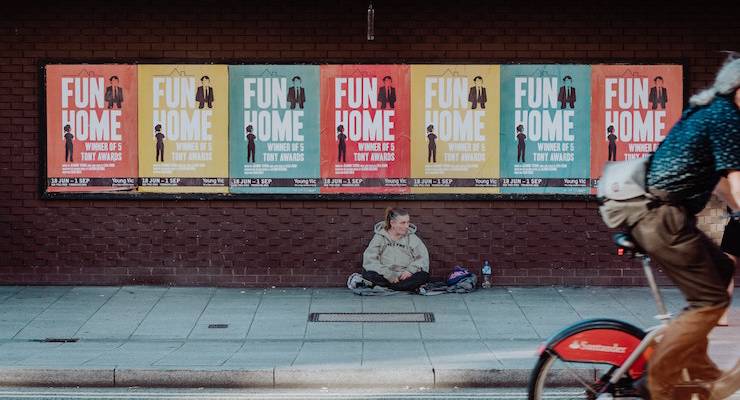
The federal government is claiming its HomeBuilder grants as a roaring success. More than 75,000 people have applied for the cash, mostly to build new homes, and the government estimates hundreds of thousands of tradies have been kept in work during the pandemic as a result.
The program is expected to cost around $2 billion and support $18 billion worth of residential construction projects.
But a new report from the Productivity Commission has found that, across the last decade, no progress has been made in reducing the number of people suffering from rental stress. Women aged over 55 are the fastest-growing cohort of homeless Australians, while nearly half a million women aged over 45 are at risk of homelessness.
Would the cash allocated for HomeBuilder be better spent on social housing?
A lesson from the GFC
The Productivity Commission’s new report found that around 50% of low-income households are facing rental stress and 33.6% of people who needed specialist housing didn’t have their housing needs met in 2019-20 (an increase of 4.9% when compared with 2015-16).
This has gotten worse during the pandemic: 63% of renters had changes to their income or employment and about a third were struggling to pay their bills or skipping meals to make ends meet. Importantly, social housing gets people off the streets which, as the pandemic has shown, can be crucial in protecting the health of many.
More than 800,000 Australians lived in social housing in 2017-18. Rent is generally set at a quarter of a tenant’s income, thus reducing a tenant’s risk of homelessness.
During the 2008 global financial crisis, the Rudd government implemented the Social Housing Initiative, building 19,500 social housing units and refurbishing another 80,000 over two years, at a cost of $5.2 billion. Social housing doubled between 2008-2018.
Labor has called for the Morrison government to invest half a billion dollars to fast-track repairs in social housing, with 25% of homes needing urgent repairs and maintenance. It’s argued that this would create a similar construction boom.
Social housing offers more than just a home
Professor of housing research at the University of Adelaide Emma Baker told Crikey that comparing HomeBuilder to social housing programs was like comparing apples and oranges.
“The grant isn’t really a housing intervention, it’s a subsidy to the building industry,” she said.
“It’s an untargeted intervention that’s probably not changing the number of houses built in the long term but just bringing their construction date forward.”
She adds that bricks and mortar is far from the only thing needed to address the rate of homelessness. “When people fall out of housing it’s often not because they can’t afford rent but because they have really complex other things in their lives like episodic mental health issues that mean they’re not capable of maintaining tenancy.”
Social housing often links tenants to health, counselling and employment services.
We haven’t seen the full effects of COVID-19
Last year, 3.4 million Australians dipped into their superannuation to help cover costs during the pandemic. Baker worries this will lead to a spike in homelessness in a few decades time, especially among women. The average superannuation payout for women is a third of the payout for men.
“There’s a widening gap between Australians,” she said. “Every dollar they’ve taken out of their superannuation will have a big impact when they retire, while there’s a lot of people whose employment has stayed secure.”
Australia’s homelessness rate is also likely to surge as JobSeeker is reduced to pre-pandemic levels (just $40 a day). Around 7500 more people are projected to become homeless after the supplement ends on March 31.
“COVID-19 has amplified many of the problems we already had,” Baker said.








PLEASE stop using “gotten”.
“This has gotten worse during the pandemic:…”
Should be “This has worsened during the pandemic …”
Are/Were you a secondary English teacher. The strain of your correction was very much alike that of Mrs Jansen to me when you put a column in the wrong spot. She was not so abrupt 🙂
I will correct you now?
”Should be “This has worsened during the pandemic …”
Oh, you are only speaking casually here, in a formal fashion….
Apologies: I am out of line.
As the article says the provision of housing leads to the development of a new life. For 23 years prior to retirement I chaired a community based JobNetwork group on an honorary basis as I had a real estate business. Many people came to us for jobs and training but without stable housing it was near impossible to help them even as they desperately wanted to work.
to try to overcome these problems, particularly with women who mostly fled abuse we would guarantee my landlords the rent if they allowed us to put thes people in their homes thankfully they agreed but over many tenancy we never were called upon to pay because we were able to give social and work support and with assistance for child care and training got them into employment but the housing was the foundation of our success. This COALition Government both state and Canberra keeps demolishing welfare home and handling the land to donor mates for up market homes and token number for the tenants they kicked out.The future of housing for women very bad over the next ten years
Although there have been 75,000 applications for HomeBuilder only 2000 have been approved
The occupants of “Tent City” Fremantle could have done with some “Home Builder” grants. Instead they got Mark McGowan’s private army better known as the police. A quicker fix indeed. It’s ironic that most of the people tending these unfortunate people’s needs were the so called west-end bourgeois. They donated tents, sleeping bags, mats, food, water, vitamins and a sympathetic ear.The left wing City of Fremantle Council were nowhere to be seen and the state Labor govt with the exception of political spin and false accusations were completely AWOL. It’s ironic.
I agree with Marguerette Daisy. The use of the word “gotten” is another wretched Americanism. I have managed to reach 81 without ever using the wretched word.
Make sure that, going forward, you won’t be with us momentarily in some alternate reality.